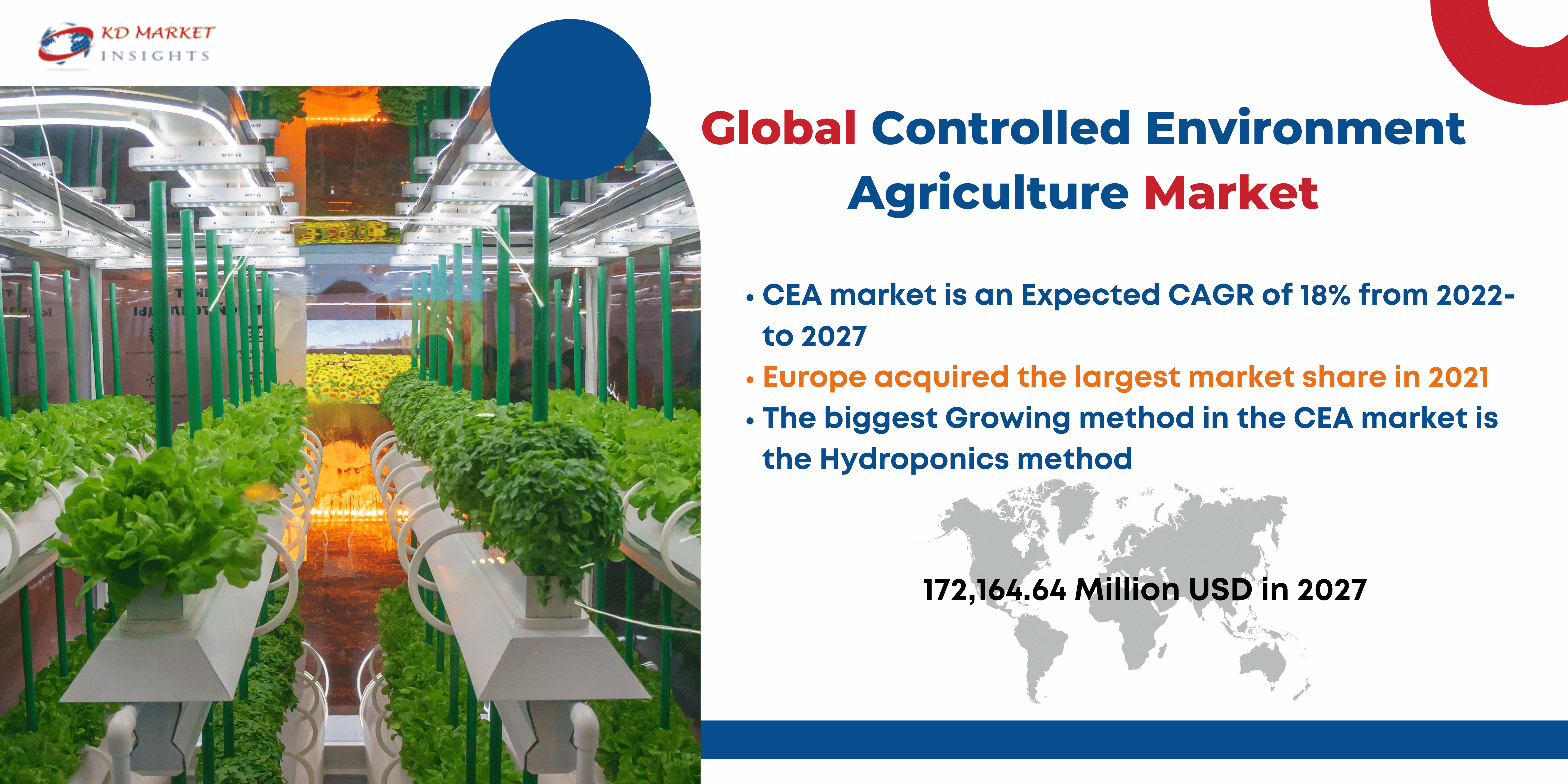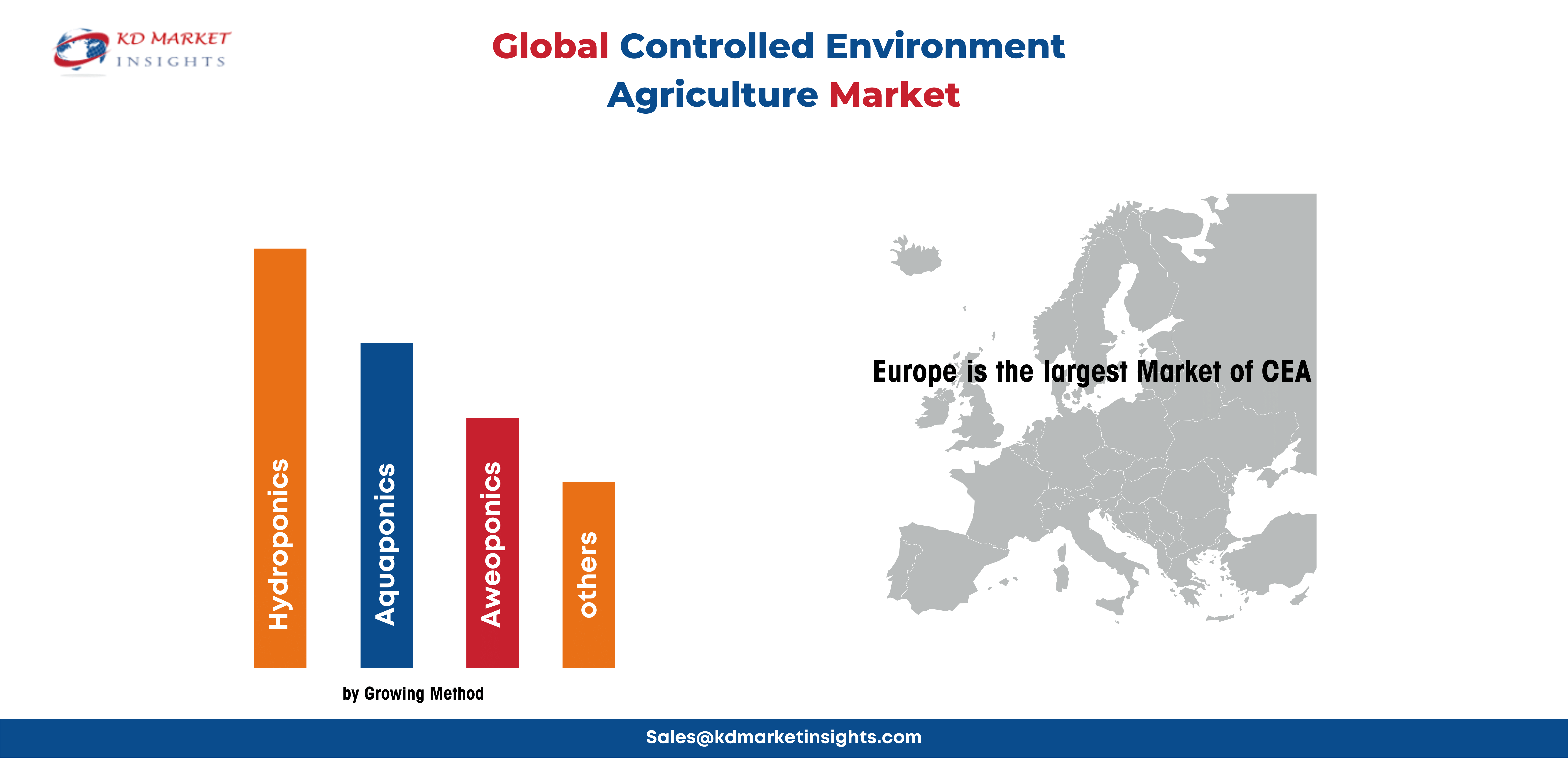Controlled Environment Agriculture Market By Crop (Lettuce & Leafy Greens, Cucumber, Tomato, Peppers, Cannabis, Strawberries, Others); By Growing Method (Hydroponic, Aquaponics, Aeroponics, Others); By Components (Lighting, Growing Media, Nutrients, Others); By Region (North America, Europe, Asia Pacific, Latin America, Middle East & Africa) - Global Market Analysis, Trends, Opportunity and Forecast, 2024-2033
Thriving Needs for New Ways to Cultivate Crops is Likely to Foster the Controlled environment agriculture Market at 18.9% CAGR during 2024 & 2033.
Global controlled environment agriculture market is projected to grow from USD 85.5 Billion in 2024 and is estimated to reach USD 270.2 Billion by 2033, registering a compound annual growth rate (CAGR) of 18.9% between 2024 and 2033.The controlled environment agriculture (CEA) market involves the cultivation of crops in a closed or partially closed environment, where environmental factors such as temperature, humidity, and light are carefully controlled. This can be achieved through the use of technologies such as hydroponics, aeroponics, and aquaponics. The global CEA market is expected to experience significant growth due to the increasing demand for fresh and healthy food, especially in urban areas, and the need for year-round crop production. The market includes various types of products such as lighting, climate control systems, sensors, and hydroponic systems, and it serves a wide range of end-use applications including fruits and vegetables, herbs, cannabis, and flowers.

Rising Global Demand for Food
The world’s population is expected to grow to almost 10 billion by 2050. It is becoming increasingly difficult to satisfy the rising global demand for food in a sustainable manner. Due to this, in order to meet the food demand of an increasing population, the government and farmers are adopting more advanced farming techniques such as Hydroponics, Aeroponics, Aquaponics, soiled based and other hybrid methods. The farmers are majorly growing leafy greens, tomatoes, cannabis, flowers, microgreens, strawberries, herbs, cucumbers, peppers, mushrooms, onions, leeks, hops, figs, sweet corn, eggplant, fish, insects, carrots, and shrimp. This rising popularity of controlled environmental agriculture techniques is resulting in an increase in the number of small and large indoor farms across the globe and these farms are also encouraging the consumption of other supplies such as nutrients, growing media, and others.
Loss of Agricultural Land
Land use across the globe is shifting from agriculture to urban and industrial uses. Changing climate has also resulted in lower production yields, loss of arable land and reduced resilience. Further, growing scarcities of natural resources have been encouraging the adoption of CEA since controlled environment farming an efficient way to produce more food with fewer resources than conventional farming, without being dependent on arable land availability and external climate conditions.
Strong Demand for Local Foods
Today, 55% of the world’s population lives in urban areas, a proportion that is expected to increase to 68% by 2050. Yet, the population living in urban areas are demanding locally grown foods such as fruits, vegetables, meat, etc. CEA producers across the globe are setting up their production centers near to urban consumers to take advantage of this trend due to their proximity to urban centers. Other advantages of CEA such as the requirement of less time and expense in the transportation of crop products and better product quality are also expected to strengthen the growth of global controlled environment agriculture market in upcoming years.
Remarkable Advantages of CEA
Conservation of water and nutrients is one of the many advantages of controlled environment agriculture over conventional farming methods. These advanced farming techniques such as hydroponics, aquaponics, and other soilless farming methods are effectively preventing wastage of water and overuse of nutrients. In a controlled environment, the plants have better health and faster growth, which reduces the need for pesticides and other supplements. Owing to their good health, CEA grown produces are noticeably better in both size and quality then soil-grown crops.
Barriers in CEA Market
The high cost of Nutrients used in Hydroponics
Although, CEA allows faster plant growth throughout the year, allowing larger yields. In order to do this, like any form of agriculture, CEA production is a high-risk, low margin enterprise. Establishing a CEA hydroponic vegetable operation requires considerable capital investment. Depending on the size of the operation and the level of technology involved, the investment can run into the tens of millions of dollars. This high required investment, high operating cost and high risks a huge challenge for growers and for the controlled environment agriculture market.
Lack of Awareness & Low Adoption Rate
The awareness regarding controlled environmental farming methods in underdeveloped countries is other countries which are restricting the growth of global controlled environment agriculture market. The dominance of traditional farming methods in low-income countries such as India is slowing down the growth of CEA market.
The need of skilled Labors & Operational Complexity
CEA industry is witnessing a shortage of skilled labors, also the labor cost is considerably high in the case of hydroponics farming. The labor cost accounts for almost 15% of the total operation cost of hydroponics farming. Controlled environment agriculture requires great precision in monitoring. Growing in controlled environments and providing proper plant nutrition requires quality farm education. A high level of operating complexity is also a major restraining factor in the growth of CEA market.
|
Controlled Environment Agriculture Market: Report Scope |
|
|
Base Year Market Size |
2023 |
|
Forecast Year Market Size |
2024-2033 |
|
CAGR Value |
18.9% |
|
Segmentation |
|
|
Challenges |
|
|
Growth Drivers |
|
Controlled Environment Agriculture Market Segmentation
With respect to the growing method, the market is segmented into hydroponics, aquaponics, aeroponics and other growing methods, in this segment, the controlled environment agriculture market for hydroponics segment is expected to expand at a CAGR of 14.2% in terms of value over the forecast period i.e. 2022-2027. The global controlled environment agriculture market for the hydroponics segment accounted for USD 9,571 Million in 2021 and is predicted to reach USD 18,586.5 Million by the end of 2027. 
The market is segmented by crop into the tomato, cucumber, peppers, cannabis, lettuce & leafy greens, strawberries, and others. According to KDMI, in the crop segment, tomato segment is expected to be the most attractive market in the global controlled environment agriculture market over the forecast period. Further, this segment is projected to open new avenues for the market players and to be the most lucrative market over the forecast period. Apart from this, when compared with other segments, the strawberries segment is anticipated to attain the highest CAGR over the upcoming years i.e. 2024-2033.
The market is also segmented by components. The component segment comprises of lighting, growing media, nutrients, and other components. Further, Nutrients segment is likely to witness an increase of +300 BPS during the forecast period. Further, the market is anticipated to grow at a CAGR of 17.1% during the forecast period i.e. 2022-2027. Nutrients are a major shareholder among three (seeds, nutrients, and grow media) inputs. Growers are using nutrients in order to ensure maximum yield of their farms.
The market is also analyzed on a region basis, which includes North America, Europe, Asia Pacific, Latin America, and Middle East & Africa regions. Among which, Europe controlled environment agriculture market reached USD 36,150.0 Million in 2021 and is expected to witness a CAGR of 16.3% over the forecast period. In addition to this, Europe controlled environment agriculture market value is projected to witness a Y-O-Y growth of 17.6% in 2027 as compared to previous years. Europe controlled environment agriculture market represented a market share of 50.3% in 2021 and is likely to account for a notable market share by the end of 2027.
The key players profiled in the report include American Hydroponics, Nelson and Pade Inc., Aerofarms LLC and other major key players. These market players have adopted different business strategies, such as acquisition, product launch, merger, and partnership to stay competitive in the global CEA market.
Controlled Environment Agriculture Market: Regional Synopsis
The controlled environment agriculture (CEA) market is growing globally, with North America, Europe, and Asia-Pacific being the major regions for CEA technology adoption.
North America is the largest market for CEA, driven by the high demand for locally produced fresh produce, the presence of major market players, and the increasing adoption of CEA technologies for cannabis production.
Europe is also a significant market for CEA, with the Netherlands being a key hub for greenhouse technology and advanced horticulture. The region has a high demand for fresh produce, and the adoption of CEA technology is growing due to increasing concerns about food security and sustainable farming practices.
The Asia-Pacific region is expected to experience significant growth in the CEA market due to the rising demand for fresh produce, limited agricultural land, and increasing investment in sustainable farming practices. China, Japan, and Australia are key markets in the region.
Other regions, such as Latin America, the Middle East, and Africa, are also expected to experience growth in the CEA market as countries seek to improve food security, reduce reliance on imports, and adopt more sustainable farming practices.
Market Segmentation Analysis:
By Crop
- Lettuce & Leafy Greens
- Cucumber
- Tomato
- Peppers
- Cannabis
- Strawberries
- Others
By Growing Method
- Hydroponic
- Aquaponics
- Aeroponics
- Others
By Components
- Lighting
- Growing Media
- Nutrients
- Others
Organizations are directly concentrating on cutting edge imaginative innovations and investments in the controlled environment agriculture sector. On a global scale, major investments are being made by start-ups and established corporations in hydroponics, vertical farming, urban agriculture, and technology to optimize plant yield in controlled environments. For instance, Scotts Miracle-Gro spent USD 136 million on indoor-growing company Gavita. They also invested in other companies including Boulder’s Aerogrow, General Hydroponics Inc. and Botanicare.
Controlled Environment Agriculture Market: Recent Developments
Some recent developments in the controlled environment agriculture (CEA) market include:
Increasing investment: The CEA market has seen a significant increase in investment in recent years, with both established companies and startups raising capital to develop new technologies and expand their operations.
Use of artificial intelligence: AI is being increasingly used in CEA systems to optimize growing conditions, improve crop yields, and reduce energy consumption.
Expansion of vertical farming: Vertical farming is becoming increasingly popular, as it allows for more efficient use of space and energy. Companies such as AeroFarms, Plenty, and Bowery Farming are expanding their operations to meet the growing demand for locally produced fresh produce.
Development of new lighting technologies: The development of new LED lighting technologies is enabling growers to provide the exact spectrum of light that plants need for optimal growth, while also reducing energy consumption.
Adoption of CEA technology for cannabis production: The cannabis industry is increasingly adopting CEA technology to improve crop yields, reduce energy consumption, and maintain consistent growing conditions. Companies such as Canopy Growth and Aphria are investing in CEA technology for cannabis production.
Increasing focus on sustainability: There is a growing focus on sustainability in the CEA market, with companies investing in renewable energy and water-saving technologies, and using organic and sustainable growing practices.
Controlled Environment Agriculture Market: Key Players
- Gotham Greens
- Plenty (Bright Farms)
- Lufa Farms
- IDEA Protected Horticulture
- Green Sense Farms
- Metro Farms
- Mirai
- Sky Greens
- Greenland
- Scafil
- Aero Farms

Need Customized Report for Your Business ?
Utilize the Power of Customized Research Aligned with Your Business Goals
Request for Customized Report- Quick Contact -
- ISO Certified Logo -

















